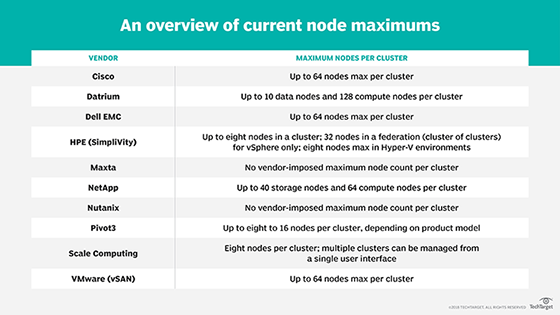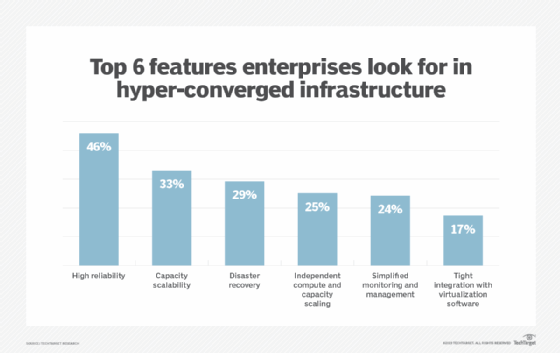
Fotolia
Top hyper-converged platform features to look for in an HCI system
Know software compatibility, maximum scalability and long-term potential of hardware support from vendors before buying a hyper-converged infrastructure system.
Purchasing a hyper-converged system is a big investment, so it is important to make sure the system you buy will meet your business's needs. As such, there are a few essential hyper-converged platform features you should look for when shopping for a hyper-converged system. These include its maximum scalability, software compatibility with existing management tools and long-term hardware support for the nodes that compose your hyper-converged infrastructure.
Scalability
The first thing I recommend checking is a hyper-converged infrastructure (HCI) platform's maximum scalability. Hyper-converged systems typically consist of a collection of individual nodes that work together to perform a specific task. In most cases, there is a limit to the total number of nodes that you incorporate into the system. This limit has a direct impact on the platform's overall scalability.

Compatibility
Another important thing to check among hyper-converged platform features is software compatibility with the HCI system. Most hyper-converged systems, for example, act as virtualization hosts. Some vendors design their systems to run a proprietary hypervisor. While that isn't necessarily a problem, you must consider your existing infrastructure and whether or not the management tools you already use will be able to manage the hyper-converged platform you're considering. If, for instance, you currently use Microsoft's System Center Virtual Machine Manager to manage your virtualization infrastructure, then a hyper-converged system that uses a proprietary hypervisor would not be able to be managed by your existing virtualization management tool of choice.

Support
Prior to purchasing a hyper-converged platform, you should also look into the vendor commitment to the platform. As previously noted, HCI systems are usually made up of individual nodes collectively working together. These nodes are commonly integrated into a proprietary chassis. If you were to purchase a hyper-converged system, and later wanted to add additional capacity, you would typically do so by purchasing additional nodes that could be installed into your chassis. If a vendor were to discontinue the nodes used by your system, it would mean that you probably would not be able to expand your HCI platform in the future. Therefore, it is critically important to make sure the HCI vendor will continue to provide both hardware and support for your hyper-converged platform for the duration of its expected life.

When it comes to hyper-converged platform features to consider, scalability and compatibility are where you should start. There are a number of other hyper-converged platform features you should keep in mind as well.
You should, for example, also give proper consideration to your storage requirements, the HCI system's network requirements, whether to go with a hardware- or software-based hyper-converged implementation, the potential for vendor lock-in and the platform's place in the whole software-defined data center stack.






